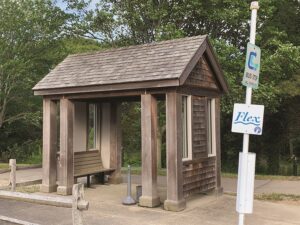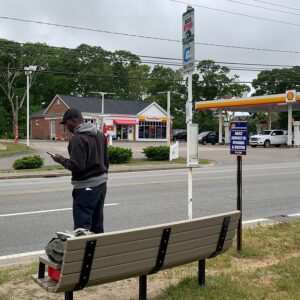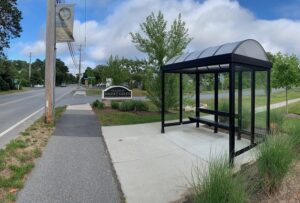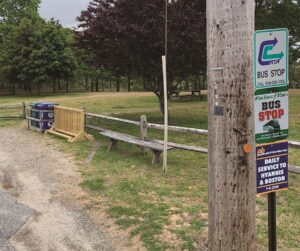EASTHAM — The select board voted on July 10 to send a letter to the Cape Cod Regional Transit Authority (CCRTA) asking that shelters be added to two bus stops: one across from town hall for riders traveling south toward Orleans and another near the Cumberland Farms at Route 6 and Brackett Road for riders heading north.

The Independent reported in June that riders had identified the stop across from town hall, near the Eastham Superette, as one of the worst on the Outer Cape — there is no shelter or bench.
“We understand that the DOT repaving plans for the Wellfleet portion of Route 6 include new bus shelters,” the Eastham Select Board wrote. “It would be fantastic if you could do two for us.”
On July 24, CCRTA Administrator Tom Cahir told the Independent that he had received that letter only when this reporter sent it to him. He said he had reached out to town staff in Eastham and to the Cape Cod Commission right away.
“We can provide bus shelters in those two locations — that’s not a problem,” said Cahir. “We have a capital budget, and we have more shelters ordered. There’s a lot of permitting involved with a state highway, but as soon as the state implications are addressed, we’re happy to honor their request.”
Cahir also said that requests for new bus shelters have been exceedingly rare during the years he has run the CCRTA. “In 14 years, this is one of probably two or three,” he said.
Requests for other improvements, such as lighting inside a shelter, just don’t happen, he said: “I’ve never had a request like that.”

A solar panel powers a few lights on the bus stop at MacMillan Pier in Provincetown. Most other bus stops on the Outer Cape are dark at night.
“Shelters are not something we talk about a lot — it’s not a big deal,” Cahir added. “If we have a request from any town for a shelter — which we never have — I would immediately send our operations team and facilities manager out to look at the site, see if it’s an appropriate location, talk to the town, and put one there.”
The shelters themselves are not particularly expensive. The wraparound shelter at the Orleans Stop & Shop is made from plexiglass, has lighting inside, and costs just under $10,000, according to Cahir.
The CCRTA has an advisory board that includes one member from each town, plus a “disabled commuter representative” and a “rider community representative” — a slot that is currently vacant.
On the Outer Cape, the four advisory board members are Provincetown’s Assistant Town Manager Dan Riviello, Truro Town Manager Darrin Tangeman, Wellfleet Council on Aging Director Suzanne Grout Thomas, and Eastham resident Roslyn Diamond.
“You have an advisory board member in each town,” Cahir said. “The select board appoints them, and if there’s any RTA-related question that people are concerned about, they should call their advisory board member and they’ll call me.
“Nothing we do is mysterious — we’re the most transparent agency around,” Cahir added.

If cost is not a constraint, however, and the process to seek improvements is straightforward, then why are so many bus stops on the Outer Cape so threadbare?
The bus stop at Provincetown’s Stop & Shop, the Outer Cape’s only grocery store, has no protection from wind or rain and no light. The bus stop at the Eastham Superette is dangerously exposed to traffic. Several Outer Cape bus stops do not have a bench, and in North Truro stop number 184 at the Sea Gull Motel and stop number 201 at Truro Vineyards don’t even have signs indicating they are bus stops.
Sylvain Lacroix, a tourist from France, rode the bus on July 24 from MacMillan Pier out to Truro to visit Highland Light. He was shocked to learn that some bus stops here don’t have signage.
“How is a person supposed to know it is a bus stop without even a sign?” asked Lacroix. “Maybe the people living right there will know, but for anyone else, how could they?”
Lacroix is an industrial engineer who studies large companies, and he tried to think about the buses from that point of view.
“If you manage the bus line, you have visibility into the buses, you can go onto them and check them, and that becomes the first priority,” Lacroix said.
Perhaps the way people actually catch the bus could become secondary in the minds of leaders at a transit organization simply because it’s harder to observe and measure, Lacroix surmised.
He also said the bus had been late compared to the published timetable.
“You don’t know when the bus will pass, or where it will stop,” Lacroix said, “but it was a very nice bus!”











